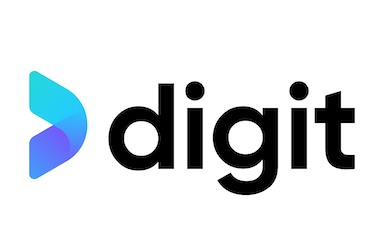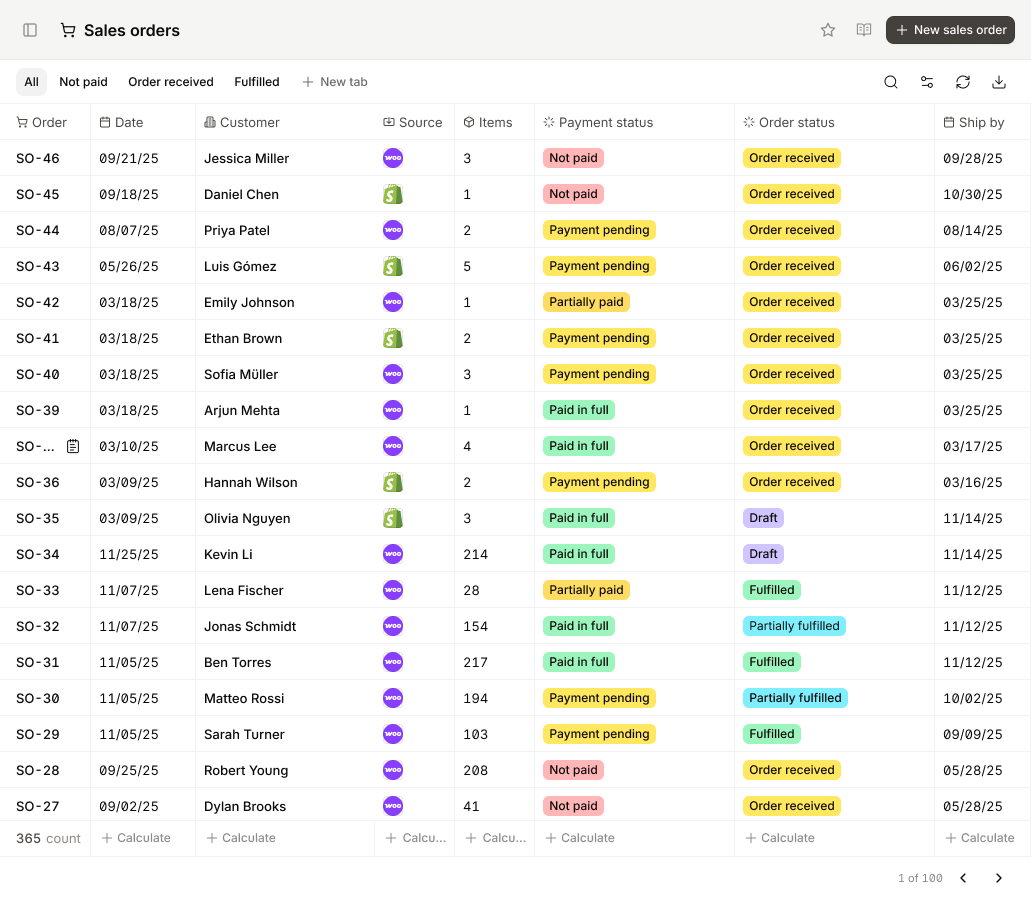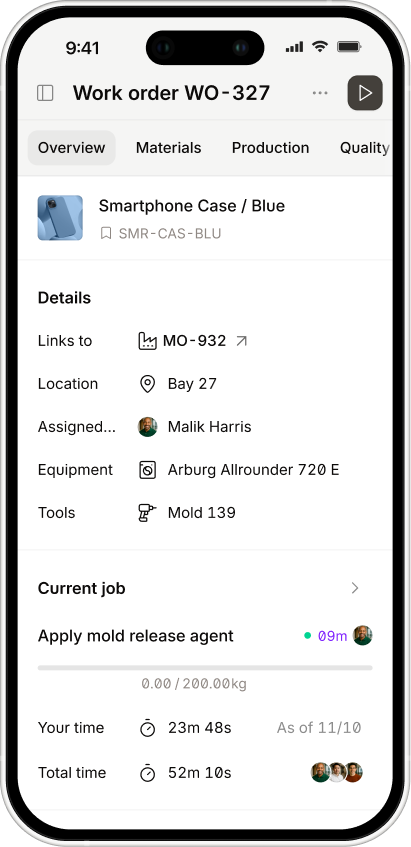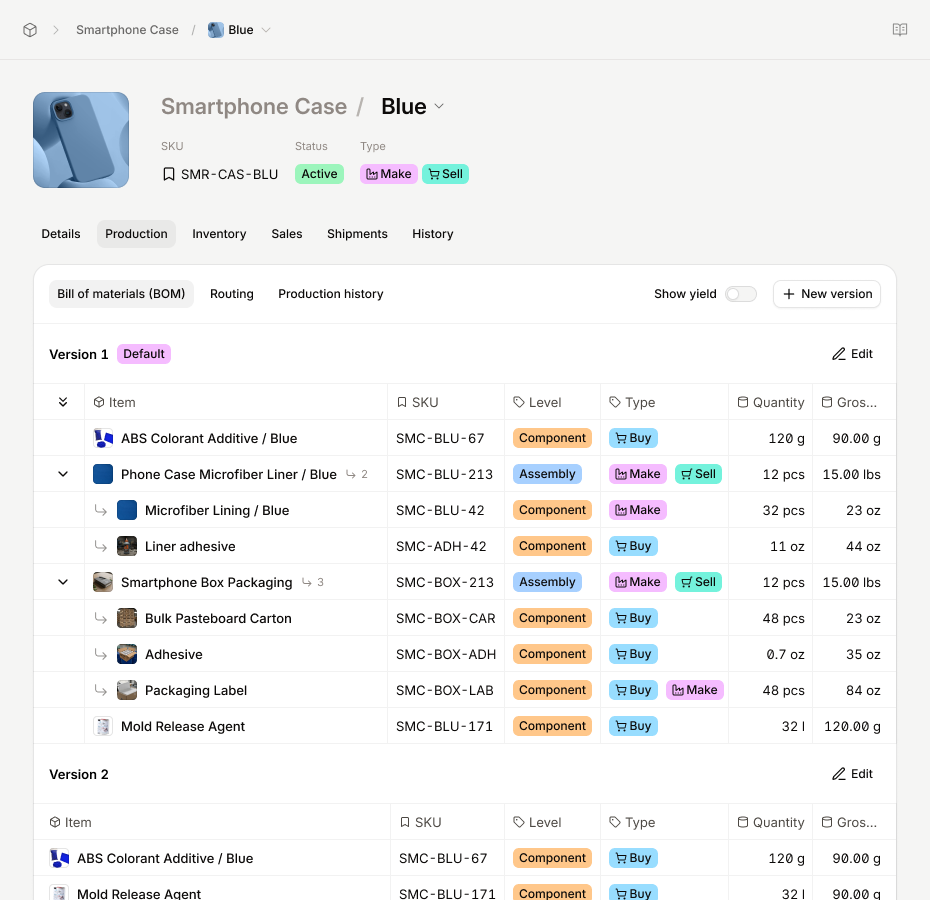What Is a Bill of Materials (BOM)?
A bill of materials (BOM) is a detailed and structured list of all raw materials, components, sub-assemblies that you need to make a product, as well as the instructions needed to manufacture it.
A BOM will typically include:
- Part ID and Description: A unique identifier and a clear, functional label.
- Quantity and Unit of Measure: Exact amounts in consistent units.
- Material and Specification Data: Standards, finishes, grades, or tolerances when they matter.
- Supplier and Cost Links: The commercial thread from engineering through purchasing to finance.
- Revision and Approval History: Who changed what, when, and why.
When teams don’t share the same BOM, design, purchasing, and production drift are doomed to fall out of sync. A BOM may seem like a small inconsequential thing, but you can already see its importance as a tool to track the true north star of a product.
What is BOM Management and Why it Matters
BOM management process consists of creating, maintaining, and communicating how the product is made, so everyone works from the same source of truth.
It’s how you make sure that you’re preventing errors and that final products are uniformed before a production run is finished. This will make sure that human expertise and the final product will always have a repeatable output.
With management defined, the next step is the data you capture and how it structures your BOM. Which will help you on getting started with building your own.
The Main Components of a BOM
There are different types of BOMs, which we will explore later, but usually the most that someone would want from their BOM is the following:
- Identification and Hierarchy: Parent–child relationships make assemblies and sub-assemblies explicit, so reuse and partial builds are easy to track.
- Material and Specification Data: Dimensions, grades, and standards ensure parts are interchangeable and quality is measurable.
- Procurement information. Approved suppliers, lead times, and negotiated pricing connect engineering decisions to purchasing reality.
- Routing References: Link components to the operation or work center that transforms or installs them.
- Revision Control and Approvals: Timestamps and sign-offs create an audit trail that help with internal reviews or external regulators.
How to Create a Bill of Materials in 8 Steps
Creating a BOM follows eight steps. The goal is one document that every department can trust and update responsibly. Here are the steps you can follow to create a bill of materials:
Step #1: Define the Finished Product
Identify the top-level item and give it a clear name, description, and internal ID.
Step #2: List every component
Record all parts, materials, and sub-assemblies required to build the product. Include consumables that affect cost or assembly too.
Step #3: Add Quantities and Units
Specify how much of each component is used, and keep units consistent across the BOM.
Step #4: Assign part numbers
Use a numbering system linked to your inventory or design files. Prevent duplication early as later cleanups take longer.
Step #5: Include Supporting Details
Add specifications, drawings, suppliers, and cost references so each line has context.
Step #6: Structure the Hierarchy
Group related parts into assemblies and sub-assemblies. This keeps the document readable and supports reuse across products.
Step #7: Review and Approve
Engineering, production, and purchasing confirm accuracy before release. Once approved, that version becomes the official build record.
Step #8: Control Revisions
Every change, material, quantity, or supplier, gets its own revision ID, date, and reason.
The Different Types of BOMs
Chances are, if you’re reading this article, you have seen what seems like a neverending list of BOM types.
If you’re confused, that is fine! But, essentially each BOM type can be used in one manufacturing business, but when and how you use those BOMs depends on how a product moves from design to production.
Hopefully, the following breakdown will make this easier to understand.
Engineering BOM (EBOM)
The EBOM captures the blueprints directly from CAD or PLM tools. It lists the items needed to satisfy form, fit, and function. It is often organized by the way engineers think about the product.
Use it when
Validating design, running FMEAs, or handing off to manufacturing.
Manufacturing BOM (MBOM)
The MBOM shows how parts are made and assembled on the line, including consumables, packaging, and the sequence of operations.
Use it when
Planning production, issuing work orders, creating work instructions, or reconciling material usage.
Service BOM (SBOM)
The SBOM defines the serviceable or replaceable components needed to maintain an asset after sale.
Use it when
Planning preventive maintenance, stocking spares, or supporting field technicians.
Multi-Level BOM
A multi-level BOM, sometimes referred to as an indented BOM, displays the hierarchy of the product, such as assemblies, sub-assemblies, parts, and consumables and how they all relate to each other.
Use it when
You need reuse across product lines, accurate rolled-up costs, or the ability to build partial assemblies.
Configurable or Modular BOM
A configurable BOM supports rules-based variation. The core stays stable as options and modules switch in and out according to what is needed.
Use it when
Great for Customers can customize their order such as size, finish, or different performance abilities. And great for you if you want to avoid maintaining dozens of nearly identical BOMs.
Best Practices for Managing BOMs
Building a BOM is one thing, but good BOM management involves creating a set of routine checks to help you keep minor errors from turning into production delays.
Here’s how you can take your BOM management to the next level by actively maintaining your documents and addressing issues in the warehouse.
1. Standardize Part Names and Numbers
Use one clear naming rule across departments. Duplicates disappear, and searches return the right record the first time.
2. Keep One Verified Source of Data
Store the active BOM where everyone can see it. Eliminate the “final-rev-2” files sitting on local drives as they always create rework.
3. Connect Costs and Suppliers to the BOM
When purchasing and engineering share the same data, margins stay visible and approved alternates are easy to apply.
4. Automate Revision Updates
Change an item once and let that change flow through production orders and purchasing lists automatically.
5. Review High-Use Products on a Schedule
Set a recurring audit (monthly or quarterly) for your main assemblies. Regular checks catch a problem earlier before it becomes a recall or a missed shipment.
6. Build Compliance into the Process
Involve quality and documentation teams at the start, not after release. Records created by the process hold up as records recreated after the fact rarely do.
Even with these practices in place, issues will surface, usually as communication gaps or version mismatches. The difference between reactive and reliable manufacturing is whether those issues are caught by the process or by the customer.
Common BOM Problems and How to Avoid Them
No process stays perfect once complexity enters the mix.
Even well-structured BOMs will still start to show signs of not being regularly updated when information changes faster than it can be documented. Recognizing the weak points early lets you tighten control before errors reach production.
- Spreadsheet Sprawl: Multiple versions circulate across drives and inboxes. A single broken formula can hide for months and surface as scrap, rework, or a missed shipment.
- Weak Cross-Team Communication: Design and production occasionally operate from different revisions. Without a change log and a single source, even careful teams produce different results.
- Missing Cost Visibility: When supplier changes aren’t saved, margins and forecasts become incorrect. Pricing and procurement drift out of sync.
- Rapid SKU Growth: As products multiply, manual methods collapse under revisions, alternates, and region-specific packaging.
Experienced teams address these by establishing a connected record of truth.
How Software Helps Manage BOMs
A lot of different inventory and manufacturing systems have one or another form of bill of materials. Regardless of what you go with, these are the core capabilities that matter most:
- Centralized BOMs: Everyone sees the same approved BOM.
- Live Connections to Purchasing and Production: Engineering changes trigger material and cost updates automatically.
- Integrated Audit Trails: Approvals, reasons, timestamps, and user IDs live with the record.
- Full Visibility: Teams can see approved versions, active materials, and current costs from design through to production.
A tool capable of doing this is Digit, and it does it by giving you access to BOMs as well as the ability to create a multi-level BOM to centralize all the important information your team needs to produce a product to the same quality and standards every single time.
Scaling BOM Control as You Grow
As you grow, so does the list of everything else.
Growth means more SKUs, more regions as you expand into different markets, more packaging, more supplier constraints, and more of a bunch of other stuff that would make this article a 10-hour read.
Getting ahead of you BOM management now means that when you do start to grow, those growing pains won’t cause you nearly as much pain as if you don’t start ahead of everything.
You might not need to do this now, but later you should start considering investing in foundations that can help you scale:
- Data Standards and APIs: Decide how parts are named and how systems exchange data, then automate the exchange.
- Analytics on Change History: Use revision logs to forecast the cost and lead-time impact of potential changes.
- Modular Templates: Launch new variants by cloning tested modules, not rebuilding from scratch.
- Operator-Friendly Execution: Digital work orders and barcode scanning tie material usage and labor to the exact version used in a run.
Cloud-based systems lower the barrier for smaller teams to adopt the same control larger manufacturers rely on.
For example, Digit gives you the tools to automate and track your bill of materials. so you can move from spreadsheet bottlenecks to a fully connected shop floor without the ERP overhead.
A bill of materials is more than documentation.
It’s the operational framework that keeps manufacturing predictable. It defines every part, quantity, and cost that turns design into delivery, and it records the changes that keep products current.
When your BOMs sit in one shared system, every change is visible and verified. Problems surface early, and scaling depends on process, not constant correction.
%201.svg)
.png)






.jpg)





